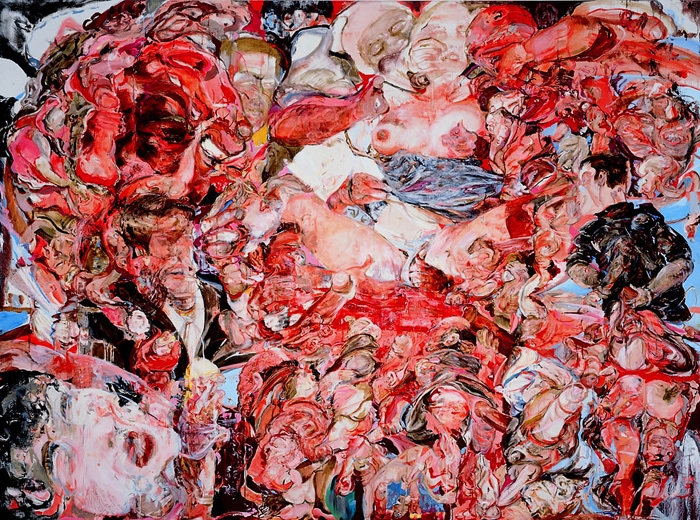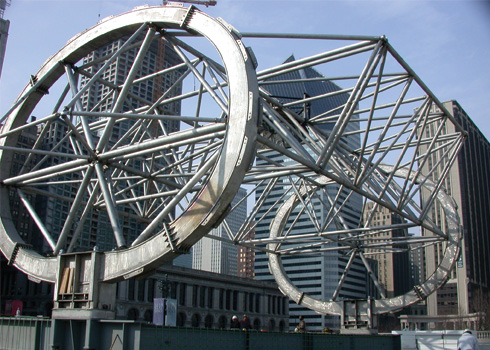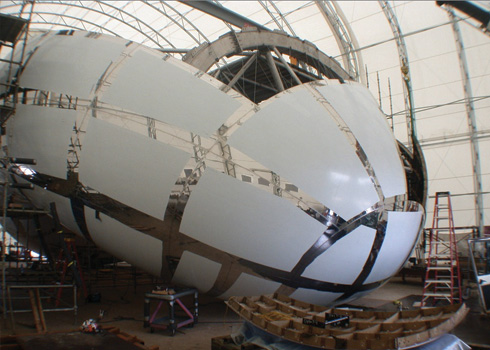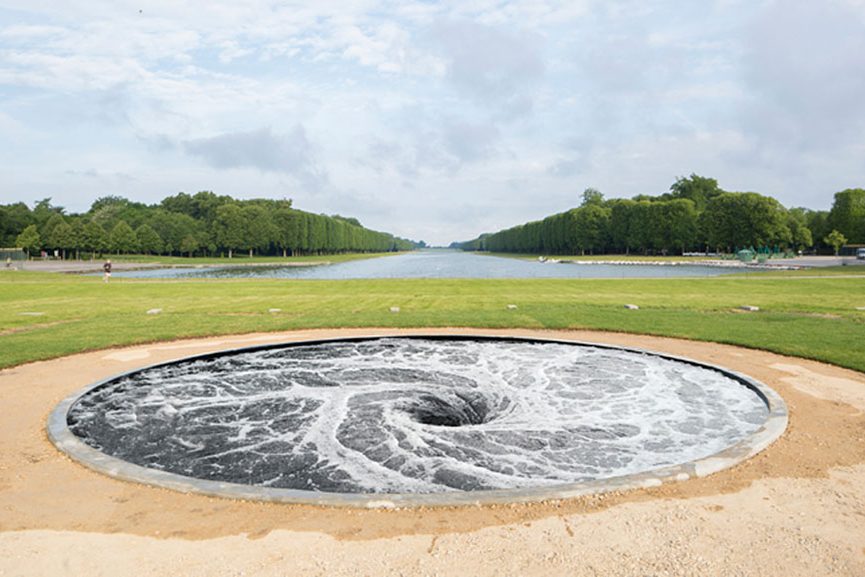Alma Nungarrayi Granites is an aboriginal artist from a desert region of central Australia. She paints a variety of stories that have been passed down in the world’s oldest continuous living culture.
Granites was inspired by her elders, who taught her to preserve, share, and maintain the Walpiri people’s “Jukurrpa” (“dreaming”) stories about the creation period. The Walpiri are aboriginal peoples of north-central Australia and number about 5,500. During the Jukurrpa (creation) period, ancestral beings traveled over the Australian desert, creating land features, animals, people and the laws. At the end of their journey, some took their places with the stars while others transformed into rocks, hills, and waters. The artist considers herself a “’carrier’ of the Jukurrpa” and wants to share her culture worldwide, through her art.
Granites lacks formal artistic training; however, she has learned from professional artists (like Paddy Japaljarri Simsand, her husband, and both parents). She has traveled to significant sites that were Jukurrpa story settings, and finds inspiration in landscapes where the land and sky blended together at sunset. The artist experiments with techniques and composition but remains true to her culture, using traditional Walpiri iconography to symbolize the Jukurrpa’s elements and sites. Her creations are a mixture of traditional aboriginal symbolism, painted horizontally on linen or canvas.
The iconography of many of Granites’ works are the stars, which were very important to the nomadic aboriginals. Considered the world’s first astronomers, aboriginals relied on the stars for guiding their movement, finding food, and charting the seasons.
Granites has simply titled several paintings “Star Dreaming” (also known as “Seven Sisters Dreaming” or “YanjirlpirrI Jukurrpa”). In these paintings, she depicts the Walpiri story of seven ancestral Napaljarri-Warnu sisters. They are located in the constellation Taurus, and are often depicted along with “Jukurra-Jukurra” (an ancestral man represented by the morning star) who is in love with the sisters. A variety of her “Star Dreaming/Seven Sisters Dreaming” paintings are shown below, which range in colors, scale, and star arrangements. Some have a softer, “photographic” appearance, while others are represented using bolder, geometric (circular, elliptical, or linear) images. The sisters are consistently shown as a star cluster in the night sky; however, sometimes they are more difficult to quickly spot.
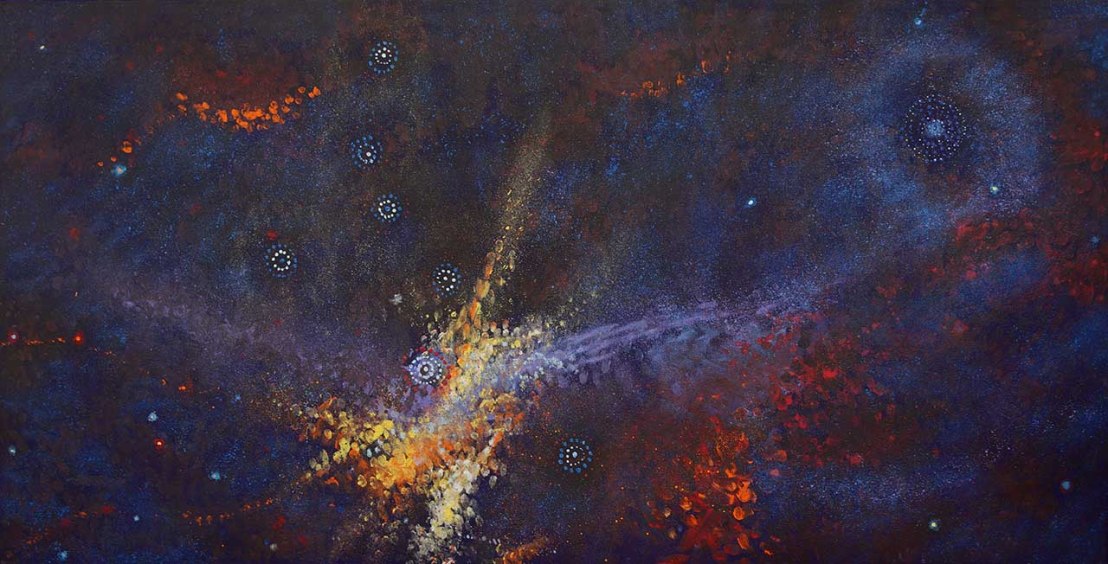
Yanjirlpirri Jukurrpa – Seven Sisters Dreaming
Acrylic on Linen
~5’ x 2.5’
https://japingkaaboriginalart.com/collections/alma-granites/

Yanjirlpirri Jukurrpa – Seven Sisters Dreaming
Acrylic on Linen
~5’ x 2.5’
https://japingkaaboriginalart.com/collections/alma-granites/

Yanjirlpirri Jukurrpa – Seven Sisters Dreaming
Acrylic on Linen
~10’ x 6.5’
https://japingkaaboriginalart.com/collections/alma-granites/
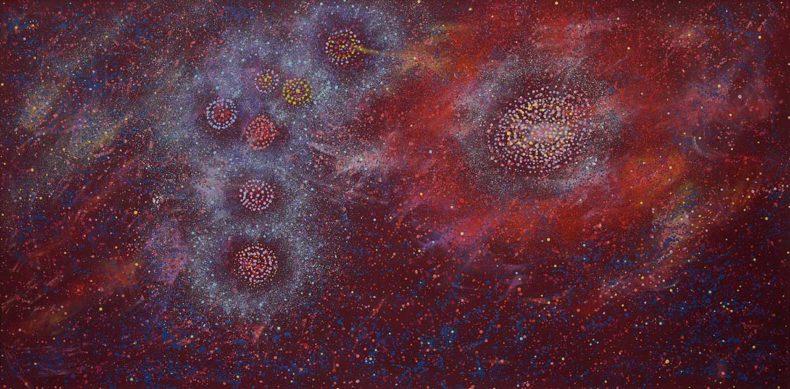
Yanjirlpirri Jukurrpa – Seven Sisters Dreaming
Acrylic on Linen
~5’ x 2.5’
https://japingkaaboriginalart.com/collections/alma-granites/

Alma Nungarrayi Granites / Star (Seven Sisters) Dreaming
Acrylic on Linen
~3.5’ x 3’
https://www.aboriginal-art-australia.com/artworks/alma-nungarrayi-granites-star-seven-sisters-dreaming-17b/
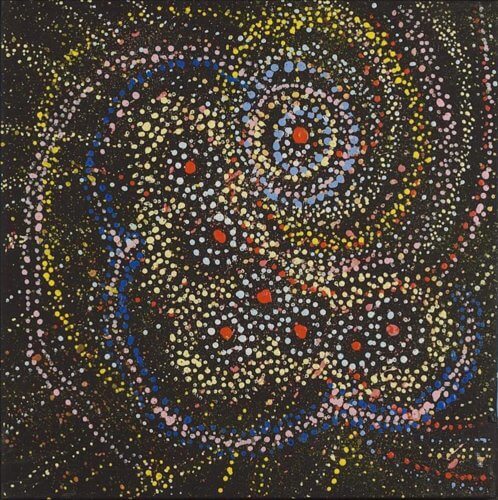
Alma Nungarrayi Granites / Star (Seven Sisters) Dreaming
Acrylic on Linen
~3.5’ x 3’
https://www.aboriginal-art-australia.com/artworks/alma-nungarrayi-granites-star-seven-sisters-dreaming-3c/
In a short video made by the Australian Museum, Granites talks about “Seven Sisters Dreaming” and the importance of sharing her culture’s stories: https://www.youtube.com/watch?v=G6RM48a92NA. (The video contains an initial warning that some people shown are now deceased; however, there is no violence in the video).
According to BlouinArtInfo writer Margaret Carrigan, aboriginal Australian art “is having a moment in America,” which began about five years ago. According to Seattle Art Museum “Of Country and Culture” co-curator Lana Meador, there is currently an interest in female aboriginal artists like Granites who are painting dream stories. She says that in the past, aboriginal works may have been shown in what was considered an anthropological approach; whereas, current exhibits are presenting these works in a fine arts context. Meador says, “We really wanted to drive home that (Granites and other aboriginal artists) – although they’re located halfway across the world, perhaps in very remote communities and, in many cases, without any exposure to or little knowledge of the contemporary art market or what is happening in the contemporary art elsewhere – are working with the same tools as so many other artists: paints and canvas. They should be included in the global conversation going on in contemporary art today.”
The Kate Owen Gallery describes Granites’ paintings as not only communicating “the tension of the story, but the calm and whimsical nature of the night sky.” Colors and patterns immerse viewers, while timeless images transport them to a meditative state. Granites’ works provide a connection to the past yet also show the boundless beauty of space, time, and hope. Find comfort in Granites works, which continue ancient story-telling through viewing the night sky’s dependable and calming stars.
Sources:
Aboriginal Art Australia. “Alma Nungarrayi Granites/Star (Seven Sisters) Dreaming.” aboriginal-art-Australia. https://www.aboriginal-art-australia.com/artworks/alma-nungarrayi-granites-star-seven-sisters-dreaming-17b/
Australian Museum. “Yuendumu: Alma Nungarrayi Granites.” . https://www.youtube.com/watch?v=G6RM48a92NA
Carrigan, Margaret. “A Dialogue Grows Around Contemporary Aboriginal Australian Art.” Blouinartinfo International. 31 March 2017.
Japingka, Australian Aboriginal Artists. “Alma Nungarrayi Granites Paintings.” Japingkaaboriginalart.com. https://japingkaaboriginalart.com/collections/alma-granites/
Kate Owen Gallery. “Alma Nungarrayi Granites.” Kateowengallery.com. https://www.kateowengallery.com/artists/Alm532/Alma-Nungurrayi-Granites.htm
Warlykurlangu, Artists of Yuendumu. “Alma Nungarrayi Granites.” Warlu.com. https://warlu.com/artist/alma-nungarrayi-granites/
